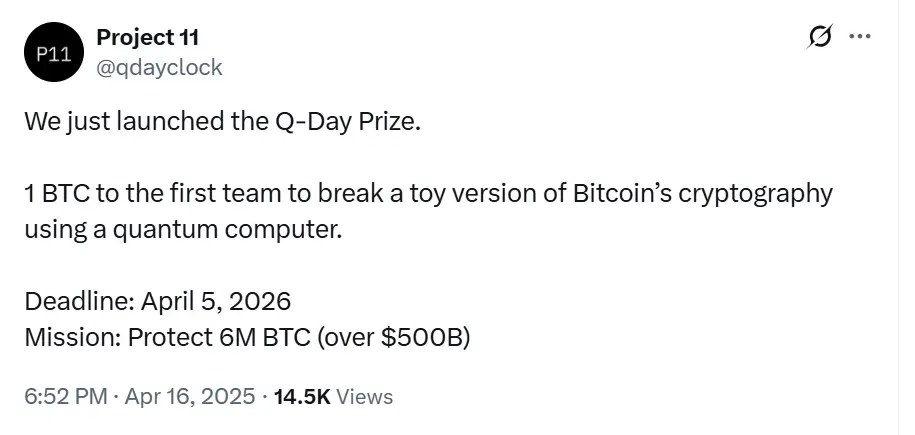Quantum computer group to all hackers: “Crack the Bitcoin code and win a BTC!”

- Over 6.2 million bitcoins could be at risk if quantum computers can one day decipher Bitcoin cryptography.
- Project Eleven’s “Q-Day Prize” aims to measure Bitcoin’s susceptibility to quantum attacks.
A research company for quantum informatics has proclaimed global competition to find out how susceptible to Bitcoin cryptography is for future quantum attacks. On April 16, Project Eleven announced the “Q-Day Prize”, in which 1 Bitcoin is awarded for the first team to succeed in cracking a cryptographic key with an elliptical curve (ECC) using the SHOR-algorithm on a quantum computer.
With the initiative, the previously theoretical quantum threat is intended to get a mealistic scale. The competition runs until April 5, 2026, while the crypto and quantum community evaluates the urgency of adapting the Bitcoin security model.

Bitcoins cryptography under quantum threat
Project Eleven announced that the price should measure how promptly a concrete threat from quantum computing is for Bitcoin core cryptography. The Bitcoin network uses the Elliptic Curve Digital Signature Algorithm (ECDSA) to secure transactions.
SHORS algorithm for quantum systems can extract private keys from public keys, and the company said that more than 6.2 million BTC – worth almost $ 500 billion – are at risk if quantum computers are strong enough.
CEO Alex Pruden said that the Q-Day Prize should bring the discussion about quantum risks from theory to practice. He said that there is no clear idea of how close we are at a “quantum apocalypse” in which Bitcoin cryptography can be broken.
The company made it clear that an ECC key has never been broken in the real world. The challenge does not require that a full 256-bit key will be cracked; Even partial success would mean great progress. “You don’t have to crack a Bitcoin key. A 3-bit key would be a great news,” said Project Eleven. In order to ensure integrity, only quantum native procedures are approved – no classic abbreviations or hybrid models are allowed.
Post quantum applications face technical and governance hurdles
Quantum defense is researched. A recently published Bitcoin Improvement Proposal (GDP), the Quantum-Resistant Address Migration Protocol (QRAMM), suggests a hard fork to force migration to post-quantum cryptography. However, an industry consensus for such a change is a long way off. The quantum startup BTQ proposed to replace the Bitcoin work proof using a quantum-based method, coarse-grained Boson Sampling (CGBS), but that would require a tough split.
Large technology companies, including IBM, Google, Microsoft, Amazon and Alibaba, are driving quantum research. Microsoft has achieved a breakthrough with its Majorana-1 chip, which uses topological qubits. The Heron chip from IBM and the Willow chip from Google reports reported 156 and 105 quBITs. Project Eleven estimates that at least 2,000 logical, error-corrected qubits would be required to crack a 256-bit ECC key. Such a system could come onto the market within a decade.
Bitcoin developer Jameson Lopp stood in March festThe fact that the extent of the quantum threat was still unalterable agreed that the conversation had to begin. The CEO of Tether, Paolo Ardoinino, repeated this in February and said that the threat is real, but he expects quantity-proof Bitcoin addresses before a larger crisis can develop.







No Comments